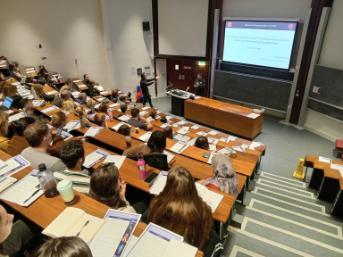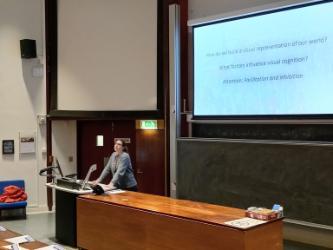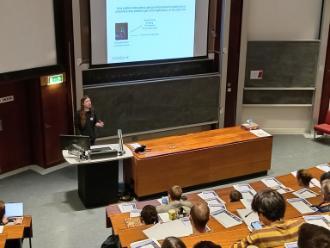The afternoon event consisted of 8 presentations from new members of University of Bristol staff and one keynote talk from Prof Krishna Singh at Cardiff University.
Summaries of the research presented:
Johan Alsiö (Lecturer, School of Physiology, Pharmacology and Neuroscience): The neuropsychopharmacology of cognitive flexibility. Cognitive flexibility, the ability to adapt behaviour in response to a changing environment, is disrupted in several neuropsychiatric disorders, including obsessive–compulsive disorder and major depressive disorder. Johan and his lab are looking at effects of manipulating serotonin and dopamine function across two species (rats and humans) on latent processes supporting choice behaviour during probabilistic reversal learning, using computational modelling.
Carole Fureix (Lecturer in Behavioural Physiology, Bristol Veterinary School): Validating elevated waking inactivity in the home-cage as a depression-like state indicator in mice. Accurate assessment of animal welfare together with a better understanding of how animals perceive, respond to and are affected by welfare challenges, are all essential to understand and mitigate the impact of housing and husbandry procedures on welfare. Carole aims to validate novel indicators of animal affective states, and is particularly interested in testing the hypothesis that elevated waking inactivity in animals can indicate failures to adapt to welfare-challenging environments, and particularly depression-like states.

Krish Singh
Kevin Wilkinson (Lecturer in Molecular Neuroscience, School of Physiology, Pharmacology and Neuroscience): Synaptic protein trafficking in health and disease. Kevin looks at how protein interactions and post-translational modifications determine how these proteins get to the right place, at the right time. Using cultured neurons he uses a combination of biochemistry, imaging, proteomics and gene expression techniques to examine molecular mechanisms along the cellular membrane. The balance between excitatory and inhibitory transmission is crucial to neuronal function and is perturbed in diseases such as epilepsy; identifying these mechanisms has potential to improve brain health.
Brandi Lee Drisdelle (Lecturer, School of Psychological Science): Exploring the neural mechanisms of salient distractor suppression. There is a growing body of research demonstrating that the capture of attention by a single salient distractor can be prevented via proactive suppression. Brandi uses behavioural and electrophysiological measures to investigate the existence and time course of multiple-item suppression, demonstrating that signal suppression processes can be adaptively employed to counteract visual distraction at different locations, in order to facilitate the attentional selection of relevant objects in crowded visual environments.

Brandi Lee Drisdelle
Seán Froudist-Walsh (Lecturer in Computational Neuroscience, School of Engineering Mathematics and Technology): The anatomy of information-routing during cognition. Seán’s team investigates how areas across the brain work together to produce cognition, and how subtle changes to anatomy across brain areas can lead to the sudden emergence of new function, or dysfunction. By carefully integrating real brain anatomy data into cutting-edge neural network models, he and his lab aim to learn how anatomy defines differences in perception and cognition across species, people and time.
Krish Singh (Head of Human Electrophysiology, School of Psychology, Cardiff University): MEG-derived oscillatory markers of activity and connectivity: clinical and pharmacological applications. Krish uses non-invasive imaging of the human brain using magnetic resonance imaging (MRI) and Magnetoencephalography (MEG) and works on a number of collaborative research programmes in epilepsy, schizophrenia and Alzheimer’s disease amongst others, including studies of electrophysiological markers of genetic risk. MEG helps understand individual variability in cognitive functions, probe the fundamental neuropathophysiology of disease; generate markers that are translatable from animal models; and identify sensitive early markers of disease.

Kevin Wilkinson
Svetlana Mastitskaya (Senior Lecturer in Cardiovascular Regenerative Medicine, Bristol Medical School: Translational Health Sciences): Vagus nerve, GLP-1 and cardiac pericytes in cardioprotection. Svetlana’s research looks at the neural mechanisms of cardioprotection (any intervention which seeks to preserve the function of the heart by reducing or preventing damage, such as myocardial infarction). No-reflow, or continued impeded blood flow to ischemic tissue after relief of an occlusion, in the heart is mediated by pericytes (cells that line the capillaries throughout the body). This can be relieved by remote ischaemic preconditioning, which is mediated by vagally stimulated glucagon-like peptide 1 release. In turn, this peptide relaxes / opens up membrane transport channels, allowing blood flow back into the damaged tissue.
Lukasz Chrobok (Lecturer, School of Physiology, Pharmacology and Neuroscience): Deciphering the ticking network of the brainstem clock. The dorsal vagal complex (DVC) the major integrative centre for the mammalian autonomic nervous system. The suprachiasmatic nucleus, or SCN, is a bilateral structure located in the anterior part of the hypothalamus, and acts as the central pacemaker of the circadian timing system and regulates most circadian rhythms in the body. The DVC has been identified as a robust extra-SCN circadian timekeeping centre composed of neuronal and non-neuronal oscillators. Phasing between DVC oscillators is malleable, changes in postnatal development, and depends on long-lasting food entrainment and diet. The DVC clock controls rhythmic expression of many neurotransmitter receptors.
Alice French (Research Fellow and Proleptic Lecturer, School of Physiology, Pharmacology and Neuroscience): How has sleep evolved? Alice’s research looks at sensory processing during sleep and the evolution of sleep behaviour. Her premise is that the brain has the ability to discriminate between salient and innoculus stimuli, i.e. animals are inherently wired to balance the need for sleep, benefitting from its restorative properties, yet remain alert to dangers in the environment. Alice aims to identify sensory neurons which act as these awake sentinels and map their connectivity to sleep and arousal centres, and understand how learning influences these sensory- arousal pathways and whether learned information can be integrated into the innate circuitry of the brain.
This event was supported by the Elizabeth Blackwell Institute for Health Research.

